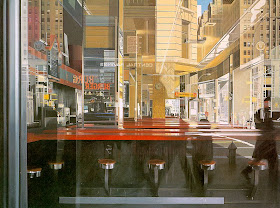The paintings of photorealist Richard Estes (born 1932) are currently being featured in a major retrospective at the Smithsonian American Art Museum in Washington.
 |
| Richard Estes, "Murano Glass," 1976, 24 x 36 inches, oil |
Calling him a photorealist is a little misleading. Although he uses photos as a source for his work, many of his paintings combine information from several different photos, and he doesn't paint over traced photographic projections. In the case of "Murano Glass," above, the reflection that you see in the window isn't actually visible in that particular store window. He had to construct the scene.
 |
| Richard Estes, "The Candy Store," 1969, 47 x 68 inches |
Painting a reflection in a shop window presents a fascinating visual challenge. Usually the street reflection is most visible in the dark areas of the window. Wherever the reflection crosses an object seen through the window, the colors and values are added to each other, such as in the slanting yellow sign.
Estes delights in creating a puzzle out of all the overlapping layers of information. In the painting above, the interior ceiling forms slant across reflections of buildings in the upper right. Some signs, such as "Burger" are reflected twice by parallel planes of glass or mirrors.
Painting reflections + transparency from observation rather than from photos is a much greater challenge because one has to overcome the effects of stereoscopic vision and focal depth. Whereas a camera will compress reflections and transparencies into a single plane, our eyes and brains separate them, so that it's almost impossible to perceive the combined effects of transparency and reflection at the same time.
-----
Here's an example where I try an outdoor painting of reflections and transparency from observation.
Richard Estes at the Smithsonian American Art Museum through February 8.
New book related to the exhibition: Richard Estes' Realism

































